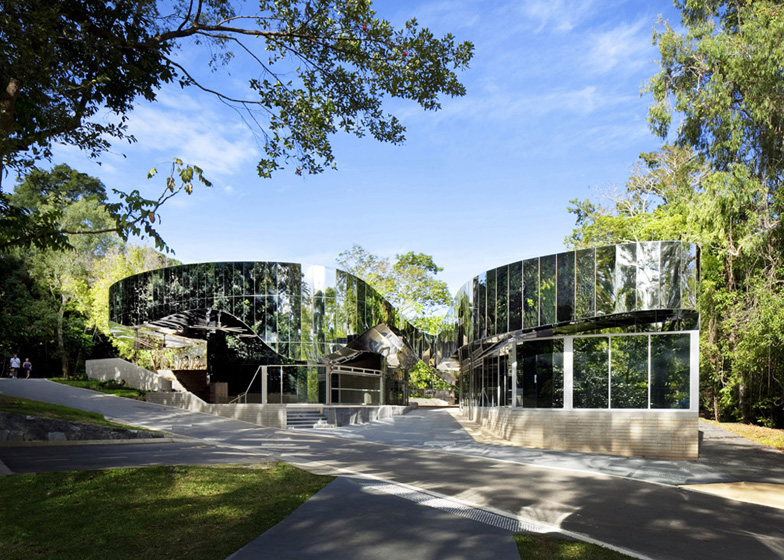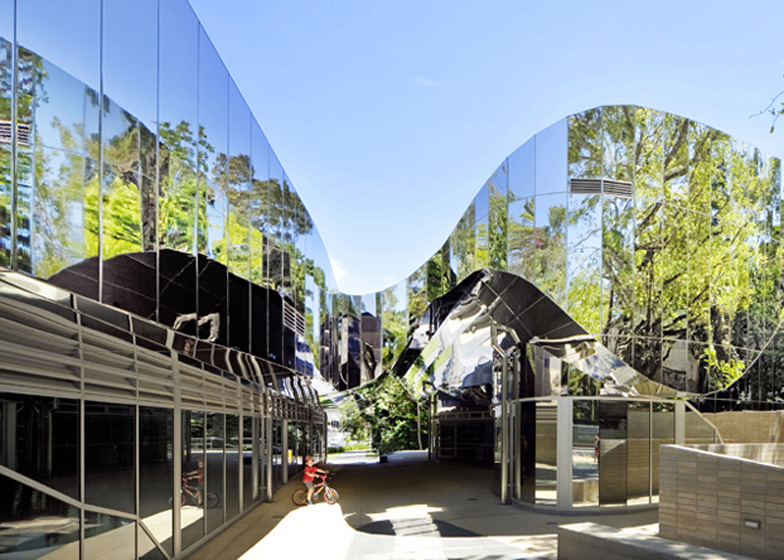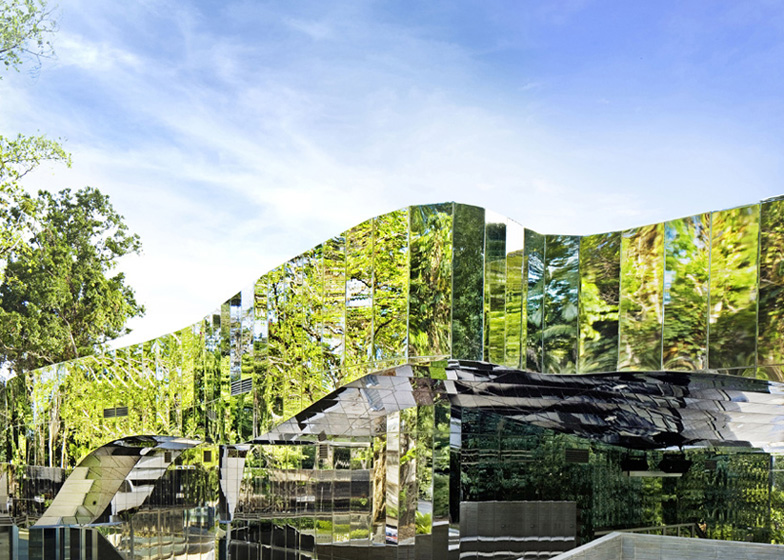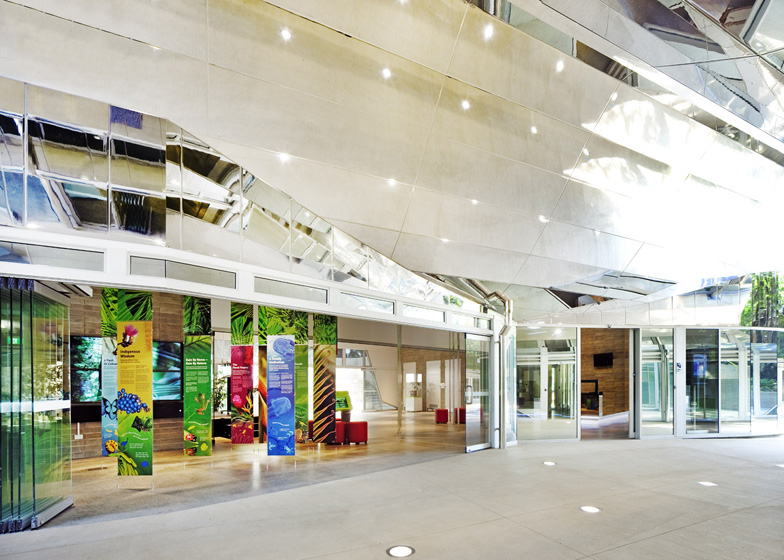This mirror-clad visitor centre by Australian firm Charles Wright Architects was designed to be invisible amongst the surrounding trees of the Cairns Botanic Gardens in Queensland.
Comprising two buildings and a dividing promenade, the visitor centre was designed as a gateway to the gardens, which contain a selection of tropical plants from northern Australian rainforests as well as from across Southeast Asia.
Charles Wright Architects drew inspiration from the suit worn by the alien-hunter in the 1987 movie Predator to give both buildings a reflective outer coating that would play down their impact on the park landscape. "We proposed a design which literally reflects the gardens as camouflage for the building," explain the architects.
Rather than cover the surfaces with a single polished plane of metal, the architects added a series of flat panels that break the facade down into facets. Each one sits at an incrementally different angle and helps to muddle the reflected images.
The pedestrian promenade runs across the site from east to west. To the north, one building contains a cafe and exhibition area for visitors, with a multi-purpose hall and a courtyard amphitheatre, while to the south a second block accommodates staff offices that open out to a long and narrow terrace.
Both buildings have non-linear shapes, generated by the routes of predefined pathways and locations of mature trees. They also have to nestle against the landscape at one end where the ground starts to climb upwards around them.
Charles Wright Architects have offices in Melbourne and Shanghai. The firm also recently completed a house that can withstand powerful cyclones. See more architecture in Australia.
See more stories about mirrors on Dezeen, including a polished steel pavilion by Foster + Partners and a playground pavilion in Copenhagen.
Photography is by Patrick Bingham Hall.
Here's a project description from Charles Wright Architects:
Cairns Botanic Gardens Visitors Centre
Conceptual framework
We set-out to design a "green" building which represents a paradigm shift for Cairns, moving away from the conventional building vernaculars toward new and progressive solutions that can be applied anywhere on a tropical latitude. There was a collective desire to attract both national and international attention, which would also aid in creating new opportunities and connections to existing facilities, communities and groups.
Public and cultural benefits
A new, iconic gateway into the botanic gardens and tanks arts centre precinct – "a democratic public space under-cover" – a challenging new architecture for the tropics which will act as an attractor to assist Cairns in its mission to be seen as a progressive city nationally and globally significant.
Relationship of built form to context
Council called for the building to be long, low and blending seamlessly with the surrounding environment (ideally invisible). We proposed a design which literally reflects the gardens as camouflage for the building with visual effect similar to the suit as worn by the alien hunter in the original 1987 Predator film. We sited the new building to straddle and activate the pedestrian promenade linking the gardens with the Arts Centre, acting as an open and flexible conduit into the interpretive and performative spaces.
Program resolution
The functional brief was very tight for the allotted site and constrained by existing paths, roads, easements, mature trees and a gradient that made the delivery of universal access particularly challenging.
The northern block contains the café terrace and opens to the major interpretation display and information space.
The southern block is an office building for council staff with a naturally ventilated corridor serving a linear sequence of cellular office spaces that all open out to the shared staff terrace on the south. This thin plan configuration encourages maximum use of passive cross-ventilation, augmented by efficient ceiling fans. Individual AC control when combined with an insulated internal thermal mass helps to minimise annual energy use through a mixed mode operation.
Above: site plan - click for larger image
Integration of allied disciplines
The project team had a collective desire to develop a world-class ESD, flexible office and mixed use public facility which wasn’t reliant on complex technological solutions or costly maintenance. We collaborated closely with council's public artist to incorporate art glass within the glazed promenade facades.
Cost/value outcome
The client engaged in the choice of costed design strategies for the planning and form. There were significant mutual benefits such as the non-briefed inclusion of the informal amphitheatre as an alternative to excessively high retaining systems. The project was delivered under budget.
Above: sections - click for larger image
Sustainability
ESD initiatives include solar panels for feedback into the energy grid, stormwater harvesting tanks, mixed mode air-conditioning systems, low energy light fittings throughout, low water usage fittings, long life cycle efficiency materials and construction, solar treatment to all windows, naturally ventilated circulation corridors and shaded exposed thermal mass internally.
Response to client and user needs
Cairns Regional Council sought fresh and challenging ideas to create a memorable piece of tropical architecture, which has unquestionably been achieved. The Visitors Centre has already become a new landmark for the city.
Above: elevations - click for larger image
Principal architect: Charles Wright Architects
Project team: Charles Wright, Richard Blight, Justine Wright, Katja Tsychkova
Project manager/s Charles Wright Architects / Cairns Regional Council / Aecom
Builder: Hansen Yuncken
Structural & Civil consultant: ARUP Pty Ltd
Hydraulics consultant: CMRP Pty Ltd
Electrical & Mechanical consultant: WSP Lincolne Scott Australia Pty Ltd
Quantity surveyor: Turner & Townsend
Landscape architect: JNP Pawsey & Prowse
ESD / Energy Efficiency consultant: Brad Pinches Consulting
Size: GFA 1415m2, cost $4.7 M
Time to complete: 4 months Design & Documentation, 10 months construction
Council: Cairns Regional Council
Client: Cairns Regional Council
Design software used: Autodesk AutoCad & Revit




